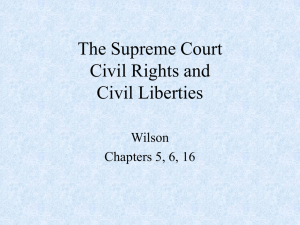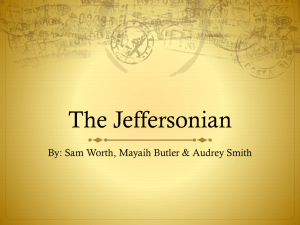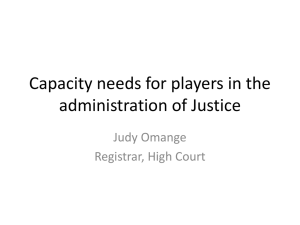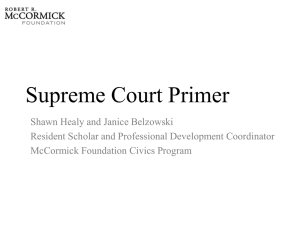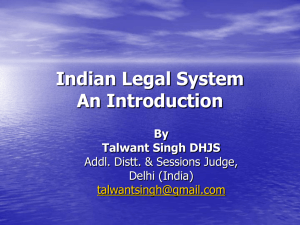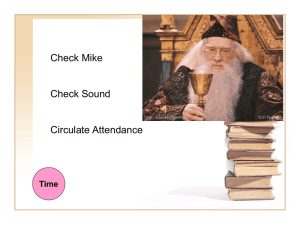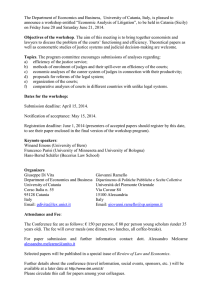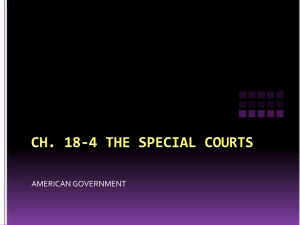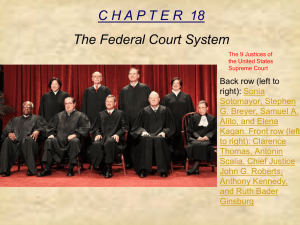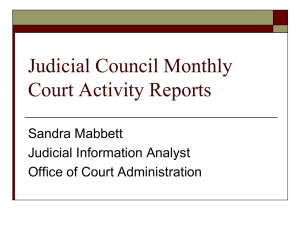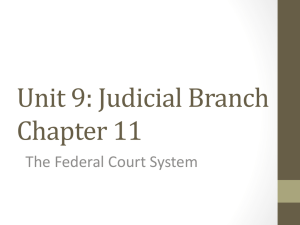Ch 16 Notes
advertisement
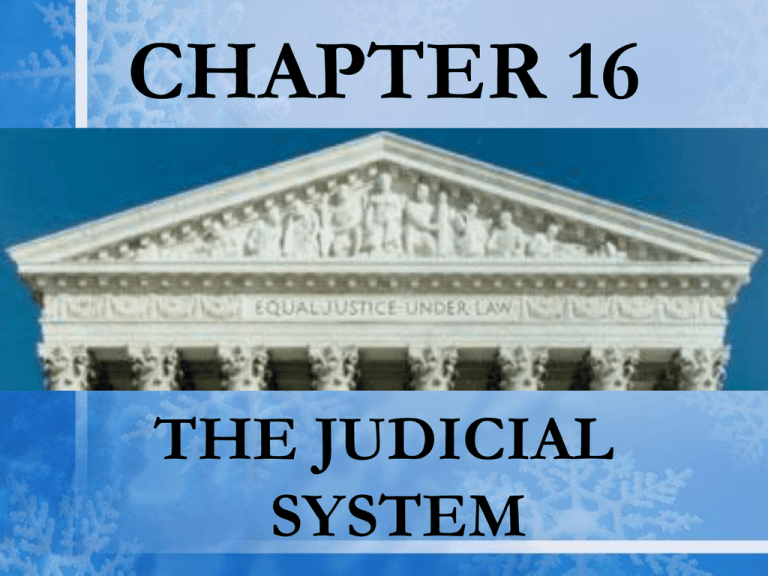
CHAPTER 16 THE JUDICIAL SYSTEM Roots of the Federal Judiciary Hamilton called it “the least dangerous branch.” Little on the judiciary in the constitution. Creates high Court, Congress establishes others. Judges have life tenure with good behavior. Congress can alter the Court’s jurisdiction. Constitution is silent on judicial review. CH 18 SUM DUAL COURT SYSTEM FEDERAL AND STATES SUPREME COURT RULES BOTH SUPREME COURT LINKS BOTH CH 18 SUM THE COURT’S POWER JUDICIAL REVIEW MARBURY V MADISON (1803) CH 18 SUM INFERIOR CONSTITUTIONAL COURTS • DISTRICT COURTS • COURT OF APPEALS • COURT OF APPEALS FOR THE FEDERAL CIRCUIT CH 18 SUM SPECIAL (LEGISLATIVE) COURTS • U.S. CLAIMS • TERRITORIAL • DISTRICT OF COLUMBIA • MILITARY APPEALS • TAX COURT CH 18 SUM THE U.S. SUPREME COURT 9 MEMBERS (NOT SET BY CONSTITUTION) TERM OF OFFICE = LIFE RELEASE OPINIONS MAJORITY CONCURRING DISSENTING THEMIS BLIND JUSTICE SCALES & SWORD THE U.S. SUPREME COURT BUILDING LOCATION OF THE U.S. SUPREME COURT BUILDING • Chief Justice – John Roberts • Associate Justices – – – – – – – Samuel Alito Stephen Breyer Ruth Bader Ginsberg Elena Kagan Anthony Scalia Sonia Sotomayor Clarence Thomas 2010 Supreme Court Official Photo Edwards, Wattenberg, and Lineberry Government in America: People, Politics, and Policy Fourteenth Edition Chapter 16 The Federal Courts The Nature of the Judicial System Two types of cases: Criminal Law: The government charges an individual with violating one or more specific laws. Civil Law: The court resolves a dispute between two parties and defines the relationship between them. Most cases are tried and resolved in state, not federal courts. Participants in the Judicial System Litigants Plaintiff—the party bringing the charge Defendant—the party being charged Jury—the people (normally 12) who often decide the outcome of a case Legal Standing have sustained or likely to sustain a direct injury Justiciable disputes - a case must be capable of being settled as a matter of law. Participants in the Judicial System Groups Use the courts to try to change policies Amicus Curiae briefs used to influence “friend of the court” briefs to raise additional points of view and information 800,000 lawyers in United States today Legal Services Corporation Lawyers to assist the poor Access to quality lawyers is not equal. Back The Structure of the Federal Judicial System District Courts (91 federal courts) Original Jurisdiction: Hear the case first and determine the facts - the trial court Case Jurisdiction - deals with the following case types: Federal crimes Civil suits under federal law and across state lines Supervise bankruptcy and naturalization Review some federal agencies Admiralty and maritime law cases Supervision of naturalization of aliens Courts of Appeal Appellate Jurisdiction Reviews legal issues in cases from lower courts Hold no trials and hear no testimony 12 circuit courts U.S. Court of Appeals for the Federal Circuit – specialized cases Focus on errors of procedure and law The Supreme Court Ensures uniformity in interpreting national laws, resolves conflicts among states and maintains national supremacy in law 9 justices – 1 Chief Justice, 8 Associate Justices Supreme Court decides which cases it will hear— controls its own agenda Some original jurisdiction, but mostly appellate jurisdiction Most cases come from the federal courts Most are civil cases SELECTING FEDERAL JUDGES Presidents nominates, Senate Confirms Use of senatorial courtesy. Competence, use of ABA ratings. Ideology or policy preferences. Rewards or political support. Religion, race, ethnicity, and gender. The Supreme Court Fewer constraints on president to nominate persons to Supreme Court President relies on attorney general and DOJ to screen candidates 1 out of 5 nominees will not make it Presidents with minority party support in the Senate will have more difficulty. Chief Justice can be chosen from a sitting justice, or as a new member to the Court CONFIRMATION IS A POLITICAL PROCESS The Backgrounds of Judges and Justices Characteristics: Generally white males – Less recently Lawyers with judicial and political experience Other Factors: Generally of the same party and ideology as the appointing president Judges and justices may not rule the way presidents had hoped they would have. Back The Courts as Policymakers Accepting Cases Use the “rule of four” to choose cases Issues a writ of certiorari to call up the case Supreme Court accepts few cases each year Making Decisions Oral arguments heard by the justices Justices discuss the case One justice will write the majority opinion Dissenting opinions Written by justices who oppose the majority. Concurring opinions Support of the majority- stress a different legal basis. Stare decisis Let previous decision stand unchanged Precedent How similar past cases were decided May be overruled Original Intent- the idea that the Constitution should be viewed according to the original intent of the framers The Courts as Policymakers Judicial implementation How and whether court decisions are translated into actual policy. Must rely on others to carry out decisions CHECKS ON THE POWER OF THE COURT • LACK OF ENFORCEMENT (NO JUDICIAL POLICE) (PRESIDENT ANDREW JACKSON) • SENATE MUST OK JUDGES • CONGRESS CAN IMPEACH JUDGES • CONGRESS CAN CHANGE # OF JUDGES • LAWS CAN BE REWRITTEN • THE CONSTITUTION CAN BE AMENDED The Courts and the Policy Agenda • A Historical Review – John Marshall and the Growth of Judicial Review • Marbury v. Madison (1803) established judicial review—courts determine constitutionality of acts of Congress – The “Nine Old Men” (New Deal) – The Warren Court – The Burger Court – The Rehnquist Court 1787-1861 ERA FEDERAL-STATE RELATIONS McCULLOCH v MARYLAND (1819) SLAVERY DRED SCOTT v SANDFORD (1857) JOHN MARSHALL 4TH CHIEF JUSTICE OF THE U.S. SUPREME COURT (1801-1835) 1862-1937 ERA GOV’T - ECONOMY RELATIONSHIP FOR PRIVATE PROPERTY RIGHTS LAISSEZ-FAIRE CAPITALISM FOR STATE REGULATION RIGHTS 1938-2000 PROTECTION OF PERSONAL LIBERTIES 2000 - ??? LIMITS OF GOVERNMENT POWER ??? PROTECTION OF SOCIETY ??? EARL WARREN CHIEF JUSTICE 1953-1969 (LIBERAL) (NIXON) WILLIAM REHNQUIST CHIEF JUSTICE 1986-2005 (CONSERVATIVE) (REAGAN) JOHN ROBERTS CHIEF JUSTICE 2005 - ???? (CONSERVATIVE) (GEORGE W BUSH) Understanding the Courts The Courts and Democracy Courts are not very democratic. Not elected Difficult to remove judges and justices The courts often reflect popular majorities. Groups are likely to use the courts when other methods fail, which promotes pluralism. There are still conflicting rulings leading to deadlock and inconsistency. What Courts Should Do: The Scope of Judicial Power Judicial restraint: judges should play a minimal policymaking role Judicial activism: judges should make bold policy decisions and even chart new constitutional ground Statutory construction: the judicial interpretation of an act of Congress STRICT CONSTRUCTIONIST APPROACH (THE LETTER OF THE LAW) V ACTIVIST APPROACH OR LOOSE CONTRUCTIONALIST APPROACH (THE SPIRIT OF THE LAW) (JUDICIAL LEGISLATION) Summary Judicial policymaking and implementation occur in lower federal and state courts. Many important questions are heard by the courts. Much decision making is limited by precedent. Even the unelected courts promote democratic values. USSC DECIDES WHICH CASES TO HEAR APPEALATE JURISDICTION FROM OTHER COURTS “THE RULE OF FOUR” ORIGINAL JURISDICTION ORAL ARGUMENTS PRESENTED FOR SOME CASES 30 MINUTES FOR EACH SIDE JUSTICES ASK QUESTIONS AT ANYTIME JUSTICES MEET IN SECRET DISCUSS VOTE OPINION ASSIGNED OPINIONS ARE WRITTEN AND RELEASED MAJORITY ABOUT 1/3 ARE UNANIMOUS CONCURRING DISSENTING COURTS PLAY A LARGE ROLE IN PUBLIC POLICY THE POWER OF JUDICIAL REVIEW COURTS = MORE POWERFUL INCREASED ROLE OF GOV’T COURTS = MORE POWERFUL AP CH 14 - THE JUDICIARY IMPORTANT TERMS-SET 1- PART A ACTIVIST APPROACH AMICUS CURIAE APPELLATE JURISDICTION BLOC VOTING CIVIL LAW CLASS-ACTION SUIT CONSTITUTIONAL COURT CRIMINAL LAW DIVERSITY CASES DRED SCOTT v STANFORD AP CH 14 - THE JUDICIARY IMPORTANT TERMS-SET 1- PART B FEE SHIFTING FRIDAY CONFERENCE JUDICIAL REVIEW POLITICAL QUESTION SENATORIAL COURTESY SOLICITOR GENERAL STANDING STRICT-CONSTRUCTIONALIST STARE DECISIS WRIT OF CERTIORARI AP CH 14 - THE JUDICIARY IMPORTANT TERMS-SET 2-PART A ACTIVIST APPROACH (JUDICIAL) BRIEF CONCURRENT OPINION COURTS OF APPEAL DISSENTING OPINION DISTRICT COURT FEDERAL QUESTION CASES AP CH 14 - THE JUDICIARY IMPORTANT TERMS-SET 2-PART B IN FORMA PAIPERIS LEGISLATIVE COURT LITMUS TEST OPINION OF THE COURT PER CURIAM OPINION PLAINTIFF SOVEREIGN IMMUNITY STRICT CONSTRUCTIONALIST APPROACH AP CH 14 - THE JUDICIARY OBJECTIVES – PAGE 1 1-EXPLAIN WHAT JUDICIAL REVIEW IS, AND TRACE ITS ORIGIN IN THIS COUNTRY TO MARBURY v MADISON. 2-LIST AND COMMENT ON THE THREE ERAS OF VARYING SUPREME COURT INFLUENCES ON NATIONAL POLICY SINCE THE DAYS OF SLAVERY. AP CH 14 - THE JUDICIARY OBJECTIVES – PAGE 2 3-EXPLAIN WHAT IS MEANT BY A DUAL COURT SYSTEM AND DESCRIBE THE EFFECTS IT HAS ON HOW CASES ARE HANDLED AND APPEALED. 4-LIST THE VARIOUS STEPS THAT CASES GO THROUGH TO BE APPEALED TO THE SUPREME COURT. 5-SHOULD THE SUPREME COURT BE “ACTIVIST” BY NATURE? AP CH 14 - THE JUDICIARY QUESTIONS 1-WHAT HAS BEEN THE HISTORY OF THE COURT’S VIEW ON ECONOMIC REGULATION? 2-WHAT WAS ROOSEVELT COURT-PACKING PLAN? WHAT DOES IT SUGGEST ABOUT THE SUPREME COURT AND OTHER BRANCHES OF GOVERNMENT? 3-HOW WOULD YOU DESCRIBE THE CULTURE OF THE SUPREME COURT? AP CH 14 - THE JUDICIARY QUESTIONS (CON’T) 4-IS THE SUPREME COURT A POLITICAL INSTITUTION? SHOULD IT BE? EXPLAIN BOTH ANSWERS. 5-IS THE POWER OF THE JUDICIARY LIMITED BECAUSE THEY LACK THE POWER OF THE SWORD AND THE POWER OF THE PURSE? 6-WHAT ARE THE CHECKS ON THE POWER OF THE JUDICIARY BRANCH? ARE THEY EFFECTIVE?
